- Home
- Quizzes
- My Quiz Activity
- Newsletters
- MY FAVORITES
- Add Sports/Teams
- SPORTS
-
NFL
- NFL Home
- Arizona Cardinals
- Atlanta Falcons
- Baltimore Ravens
- Buffalo Bills
- Carolina Panthers
- Chicago Bears
- Cincinnati Bengals
- Cleveland Browns
- Dallas Cowboys
- Denver Broncos
- Detroit Lions
- Green Bay Packers
- Houston Texans
- Indianapolis Colts
- Jacksonville Jaguars
- Kansas City Chiefs
- Las Vegas Raiders
- Los Angeles Chargers
- Los Angeles Rams
- Miami Dolphins
- Minnesota Vikings
- New England Patriots
- New Orleans Saints
- New York Jets
- New York Giants
- Philadelphia Eagles
- Pittsburgh Steelers
- San Francisco 49ers
- Seattle Seahawks
- Tampa Bay Buccaneers
- Tennessee Titans
- Washington Commanders
-
MLB
- MLB Home
- Athletics
- Arizona Diamondbacks
- Atlanta Braves
- Baltimore Orioles
- Boston Red Sox
- Chicago White Sox
- Chicago Cubs
- Cincinnati Reds
- Cleveland Guardians
- Colorado Rockies
- Detroit Tigers
- Houston Astros
- Kansas City Royals
- Los Angeles Angels
- Los Angeles Dodgers
- Miami Marlins
- Milwaukee Brewers
- Minnesota Twins
- New York Yankees
- New York Mets
- Philadelphia Phillies
- Pittsburgh Pirates
- San Diego Padres
- San Francisco Giants
- Seattle Mariners
- St. Louis Cardinals
- Tampa Bay Rays
- Texas Rangers
- Toronto Blue Jays
- Washington Nationals
-
NBA
- NBA Home
- Atlanta Hawks
- Boston Celtics
- Brooklyn Nets
- Charlotte Hornets
- Chicago Bulls
- Cleveland Cavaliers
- Dallas Mavericks
- Denver Nuggets
- Detroit Pistons
- Golden State Warriors
- Houston Rockets
- Indiana Pacers
- Los Angeles Clippers
- Los Angeles Lakers
- Memphis Grizzlies
- Miami Heat
- Milwaukee Bucks
- Minnesota Timberwolves
- New Orleans Pelicans
- New York Knicks
- Oklahoma City Thunder
- Orlando Magic
- Philadelphia 76ers
- Phoenix Suns
- Portland Trail Blazers
- Sacramento Kings
- San Antonio Spurs
- Toronto Raptors
- Utah Jazz
- Washington Wizards
-
NHL
- NHL Home
- Anaheim Ducks
- Boston Bruins
- Buffalo Sabres
- Calgary Flames
- Carolina Hurricanes
- Chicago Blackhawks
- Colorado Avalanche
- Columbus Blue Jackets
- Dallas Stars
- Detroit Red Wings
- Edmonton Oilers
- Florida Panthers
- Los Angeles Kings
- Minnesota Wild
- Montreal Canadiens
- Nashville Predators
- New Jersey Devils
- New York Islanders
- New York Rangers
- Ottawa Senators
- Philadelphia Flyers
- Pittsburgh Penguins
- San Jose Sharks
- Seattle Kraken
- St. Louis Blues
- Tampa Bay Lightning
- Toronto Maple Leafs
- Utah Mammoth
- Vancouver Canucks
- Vegas Golden Knights
- Washington Capitals
- Winnipeg Jets
- NCAAF
- NCAAM
- Olympics
- Boxing
- Entertainment
- Lifestyle
- Golf
- MMA
- Soccer
- Tennis
- Wrestling
- Sports Betting
- More Sports
- RESOURCES
- My Account
- YB on Facebook
- YB on Twitter
- YB on Flipboard
- Contact Us
- Privacy Policy
- Terms of Service
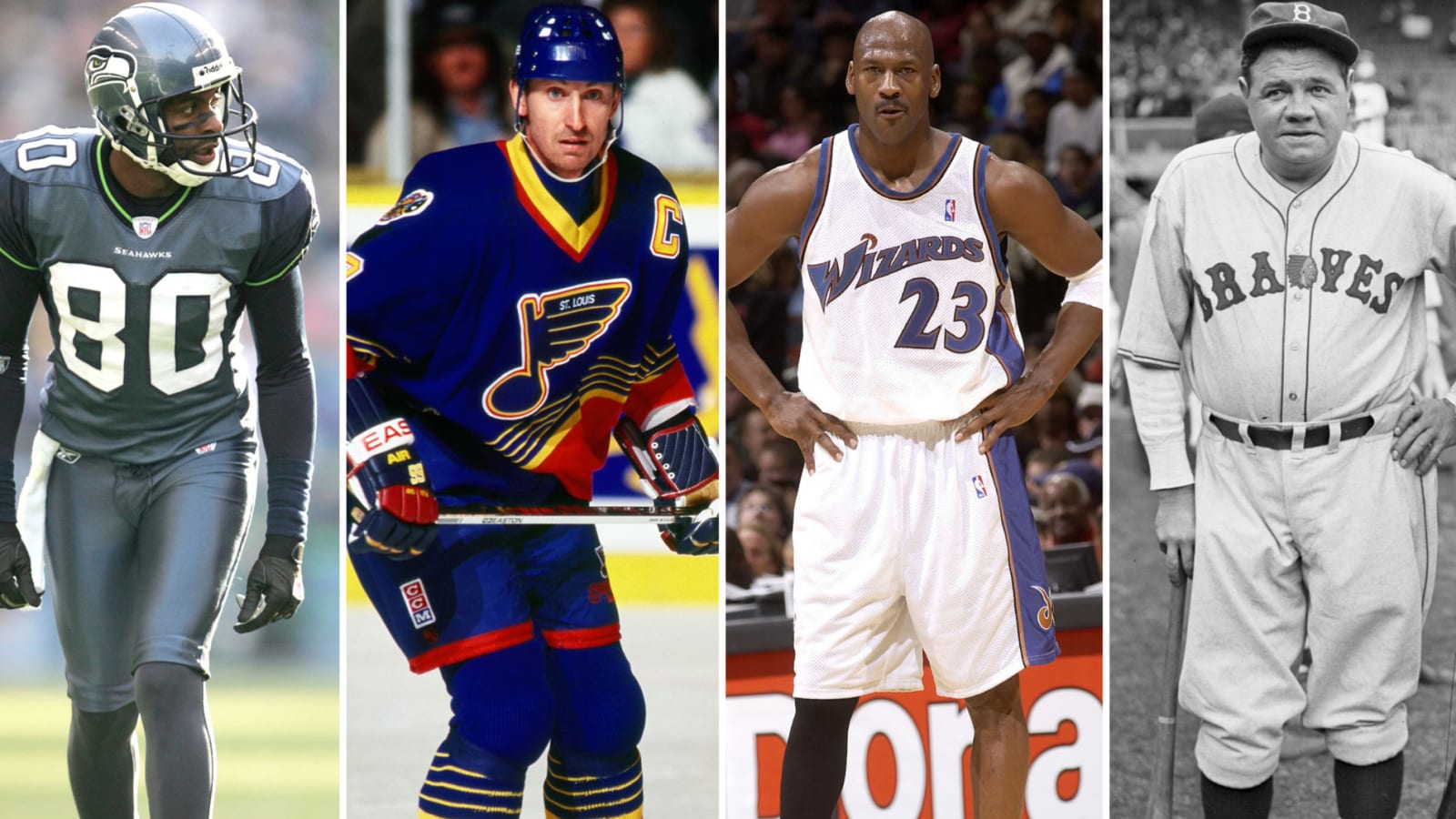
75 iconic superstar athletes wearing unusual & unfamiliar uniforms
There are indelible images of certain athletes in specific uniforms. Barry Sanders wearing the Honolulu blue and silver of the Detroit Lions, for example. Sidney Crosby and Mario Lemieux will forever be wearing Penguins sweaters. One need not be a one-team player to be easily recognizable in multiple uniforms—Peyton Manning in a Denver Broncos uniform or Tom Brady in Tampa Bay Buccaneers colors both track. Sometimes, though, a superstar, an icon of their sport, throws the landscape into chaos. Maybe they are chasing that elusive ring. Maybe everybody else knows it is time to retire before they can accept it. Whatever the reason, these famous faces forever tied to a certain uniform found themselves in unusual attire.
Michael Jordan - Washington Wizards
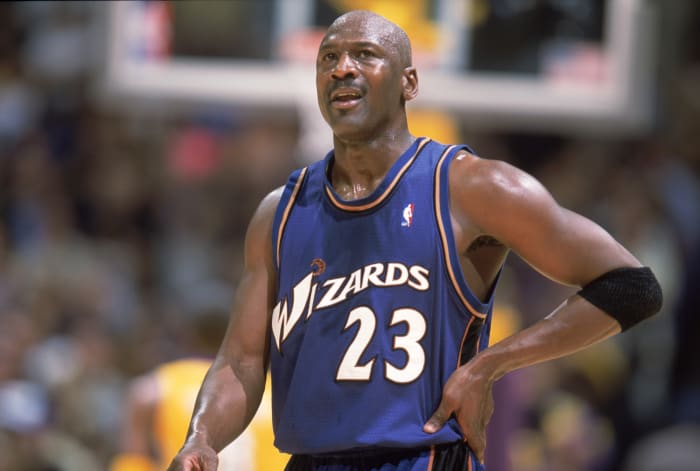
This is perhaps the most-famous example of this phenomenon. The Chicago Bulls exist as a top-level NBA franchise solely on the shoulders of Jordan, the pick of many for best player of all-time. After the “Last Dance,” Jordan retired for a second time. Once again, it didn’t take. MJ started to play for a Washington Wizards team he was previously involved with on the front office side. Though Jordan’s signature otherworldly athleticism was gone, through guile (and, admittedly, ego-driven shot hoarding) he managed to be a 20-points-per-game scorer in both of his Wizards campaigns.
Babe Ruth - Boston Braves
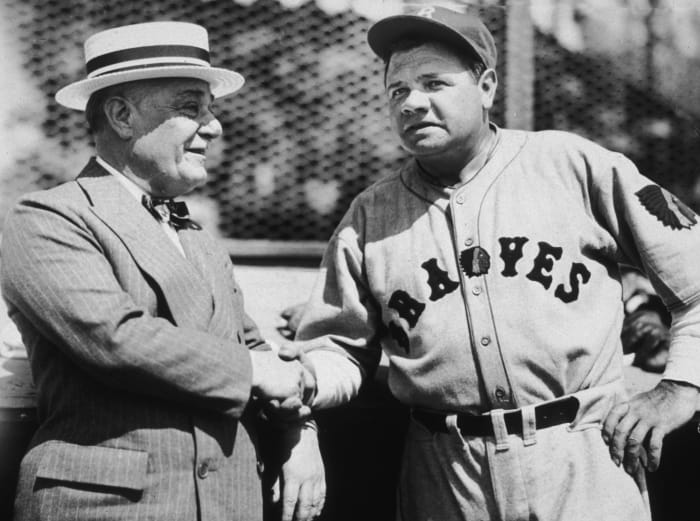
Everybody who knows anything about baseball history knows that Babe Ruth made the move from the Boston Red Sox to the New York Yankees. With the Yankees he became the foremost slugger in MLB history for generations. What is less remembered is his time with the Boston Braves, and with good reason. Babe wanted to stay in the game, but he was actually looking to become a manager when the Braves offered him a playing role, with the promise he could manage or work in the front office. That turned out to be a false promise to get Ruth to sign on, and he spent his brief time playing for the Braves mostly asking to be released from his contract. Ruth retired in June of the 1935 season, having added six more home runs to his career total.
Emmitt Smith - Arizona Cardinals

In 2002, Emmitt Smith broke the record for the most career rushing yards in NFL history. He did that with the Cowboys, the only team he had known. Instead of retiring, though, Smith moved to the Arizona Cardinals. He barely added to his total in 2003, as injuries limited him to 90 carries for 256 yards. Smith looked a bit better in 2004, rushing for 937 yards and nine touchdowns. That sufficed as a last hurrah to get the Hall of Famer to retire.
Jerry Rice - Oakland Raiders & Seattle Seahawks

It’s remarkable that, even with the rise of passing, nobody has plausibly threatened Rice’s status as the best receiver in history. After an incredible run with the 49ers, Rice moved across The Bay where he continued to play well with the Raiders. The thing is, if you remember the Raiders as Rice’s last team, therein lies the problem. During the 2004 season Rice was traded to the Seahawks. In 11 games he had 25 catches for 362 yards and three touchdowns. He considered trying to catch on with the Broncos in the summer of 2005 but opted to retire instead.
Wayne Gretzky - St. Louis Blues

Frankly, the weirdest jersey to see Gretzky in is the Blues. He played 18 games in St. Louis at the end of the 1995-96 season. Of course, Gretzky is the defining Oiler (give-or-take a Connor McDavid) and made hockey pop in Los Angeles with the Kings. Things ended with the Rangers, though. Though he was losing a step, “The Great One” was actually still a great player in his first two seasons with the Rangers, posting over 20 goals and 90 points both times. His final season, 1998-99, showed that even the greatest can’t do it forever. Gretzky had 53 assists, but only nine goals, and decided to hang up his skates.
Joe Namath - Los Angeles Rams
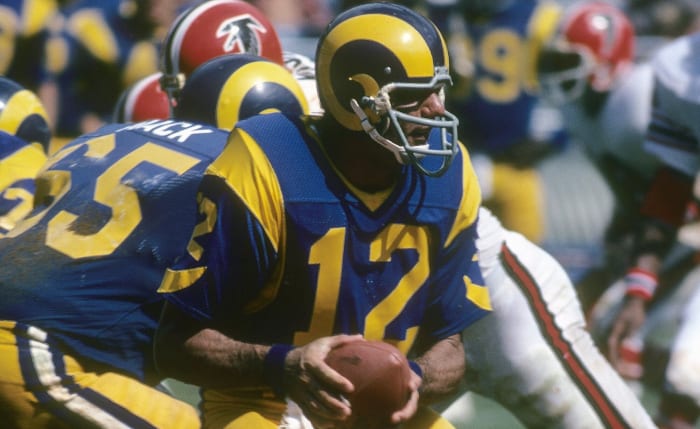
One famous guarantee and Super Bowl upset pushed Namath into the Hall of Fame even though he led the NFL in interceptions on four occasions and finished his career with more picks than passing touchdowns. In his final season as a Jet, Namath only managed to make eight starts and threw four touchdown against 16 picks. Sixteen picks! And yet, the Los Angeles Rams still gave a chance. Worn down by a long NFL career, Namath only made four starts before he was benched. He’d never play again.
Ken Griffey Jr. - Chicago White Sox
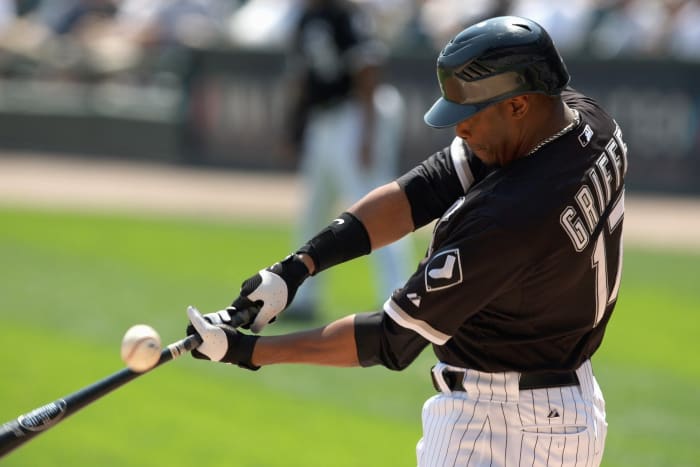
Griffey did get to end his career with a reunion tour with the Mariners, the team he rose to fame with. Between those stints he had a long run with the Reds, his father’s former team, but then there’s the tail-end of 2008 as well. Cincinnati traded Griffey to the Chicago White Sox. He got on base at a .347 clip in 41 games, but his power was not what it once was. After that brief run he moved back to Mariners to bask in the good vibes until he retired.
Brett Favre - New York Jets & Minnesota Vikings
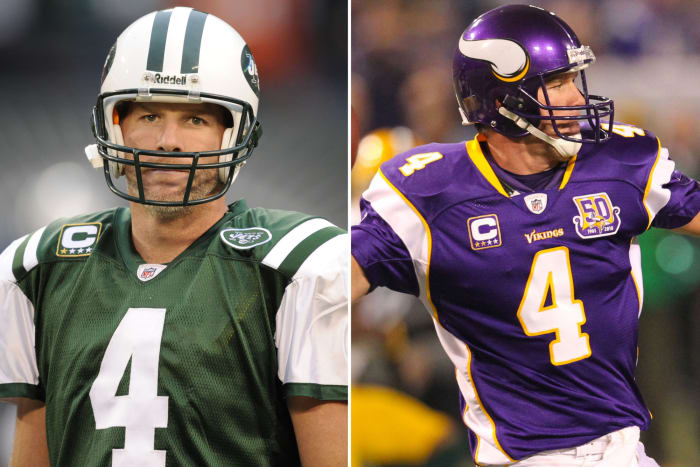
With the Packers, Favre won three MVPs and one Super Bowl, establishing himself as an all-time great. As the Packers made the move to Aaron Rodgers, he was traded to the Jets. Favre spent one season with the Jets and was…okay. He threw 22 touchdowns, but led the NFL with 22 interceptions. Not satisfied, Favre then returned to the NFC North with the Vikings. In 2009, Favre was legitimately MVP-level, and maybe he should have left it there. Instead, Favre returned for one more season, and in addition to playing mediocre quarterback, his incredible consecutive-game streak ended and he only played in 13 games.
Hakeem Olajuwon - Toronto Raptors
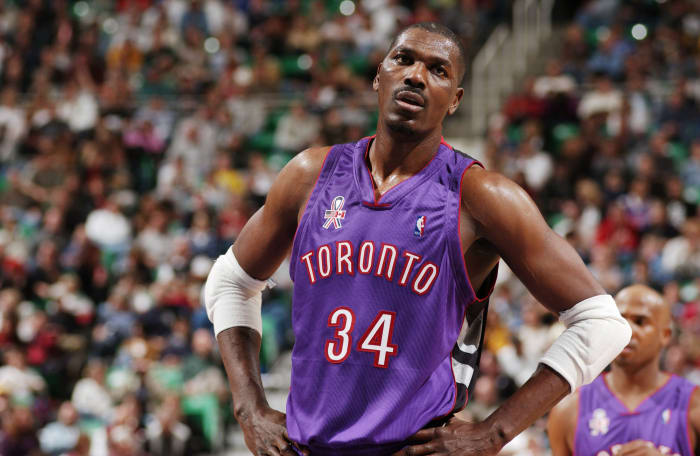
If the Rockets had to do it all over again, they’d take Michael Jordan first overall in 1984, but Olajuwon was a stellar pick as well. The Hall of Famer won all sorts of awards and led the Rockets to two titles (appropriately, the two titles during Jordan’s sabbatical from the Bulls). After a lengthy run in Houston, Olajuwon made the move to the Toronto Raptors. The Raptors were still new enough, and still purple-clad enough, to make for a strange sight. Approaching 40 and dealing with a back issue, Olajuwon averaged a mere 7.1 points per game over 61 games and decided to retire.
Franco Harris - Seattle Seahawks

Granted, Harris’ Hall of Fame resume is bolstered by four Super Bowl rings with the Steelers that he played a role in but was by no means the biggest reason for. In 1983, he rushed for 1,007 yards with Pittsburgh, which would have been a great way to go out. The Steelers seemingly saw the writing on the wall, releasing Harris during training camp in 1984. He signed with the Seahawks and proved his former team astute. Harris only managed 68 carries for 170 yards with zero touchdowns over eight games.
Mike Modano - Detroit Red Wings
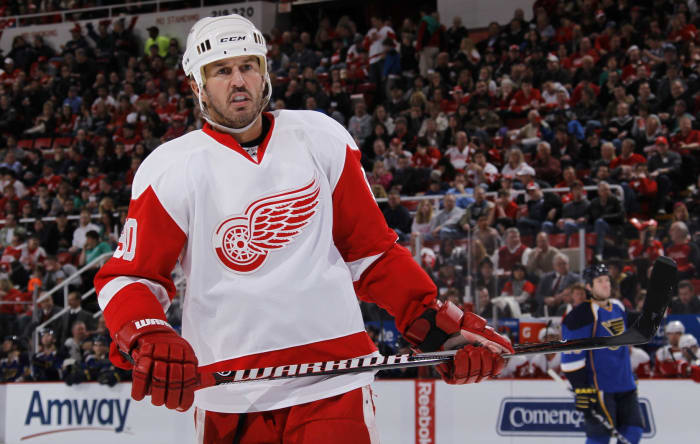
It would have been cool had Modano been a one-franchise guy. He made the move with the Minnesota North Stars down to Dallas and became the most-successful American player in NHL history. However, Modano was born and raised in Metro Detroit so at the end of his career he designed to sign with the Red Wings for a swan song with his hometown team. Hopefully he had fun, as Modano only managed four goals in 40 games.
Gordie Howe - Hartford Whalers

“Mr. Hockey” helped rewrite the record books in a major way as a Red Wing. He played for over two decades with the Wings, but he wasn’t done. Howe made the move to the WHA, which was a professional league, but maybe a half-step down from the NHL. He remained prolific with the Houston Aeros, and then the New England Whalers. Howe even got to play on a line with his sons Mark and Marty. Then, the WHA folded and the now-Hartford Whalers got the call to join the NHL. It was 1979, and for reference Howe had debuted with the Red Wings in 1946. And yet, Howe had 15 goals and 26 assists in the 1979-80 season before retiring. Well, Howe did “play” one game with the Detroit Vipers in 1997, but that was purely a promotional stunt.
Willie Mays - New York Mets

For years, it was the touchstone reference for all-time athletes who hung on for too long: You don’t want to end up like Willie Mays on the New York Mets. When he was with the Giants, Mays put together a career that has him in the running for best player in history. Even in his age-40 season with San Fran he posted a .425 OBP. The next season, after a rough start, the Giants moved Mays to the Mets. In 135 games with the Mets he hit .238 and looked lost in the outfield. Indeed, a rough way for a legend to go out.
Brett Hull - Arizona Coyotes

Hull is one of those all-timers that made an impact with a few franchises. He became a superstar with the Blues, but he was a good player and a Cup winner with the Stars, and then still a 30-goal scorer and a Cup winner with the Red Wings. Hull was also nine goals short of 750 when the NHL lost a full season due to a lockout. He returned post-lockout to play with the Phoenix Coyotes. However, five games in, and with zero goals to his name, Hull came to the conclusion he didn’t have it anymore and retired.
Joe Montana - Kansas City Chiefs

Before Jordan on the Bulls, Montana on the Chiefs was the go-to reference for the prior generation. Like Jordan, Montana was pretty good, if not his old self, with his new team. With the 49ers turning to Steve Young (which, to be fair, worked out for them), Montana moved to Kansas City. During his two regular seasons he was okay, but in 1993 he did help bring the Chiefs to the AFC title game.
Patrick Ewing - Seattle Sonics & Orlando Magic
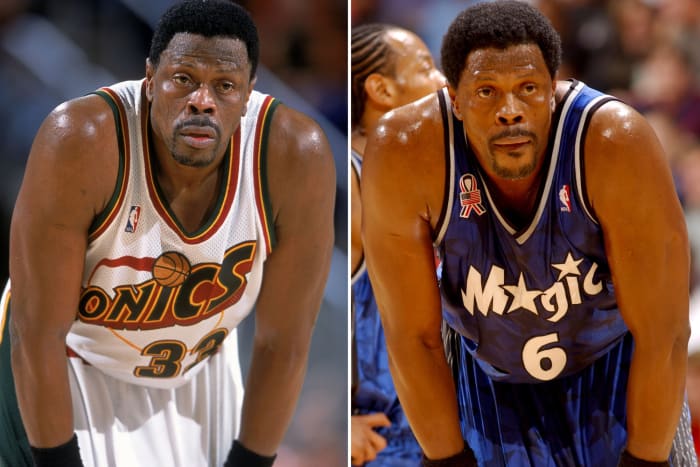
Owing in part to being the first player taken first overall by a team that won the NBA Draft Lottery, Ewing is synonymous with the Knicks. Well, that and the fact they are the New York Knicks. Spending 14 seasons with the Knicks made Ewing a famous face in sports. He also notably never won a title with the Knicks. Ewing was dealt to the Seattle Supersonics for the 2000-01 season, starting 79 games and averaging 9.6 points and 7.4 points per game. Then, he went to the Magic, but that year he didn’t even average 14 minutes a night coming off the bench before retiring.
David Beckham - Los Angeles Galaxy
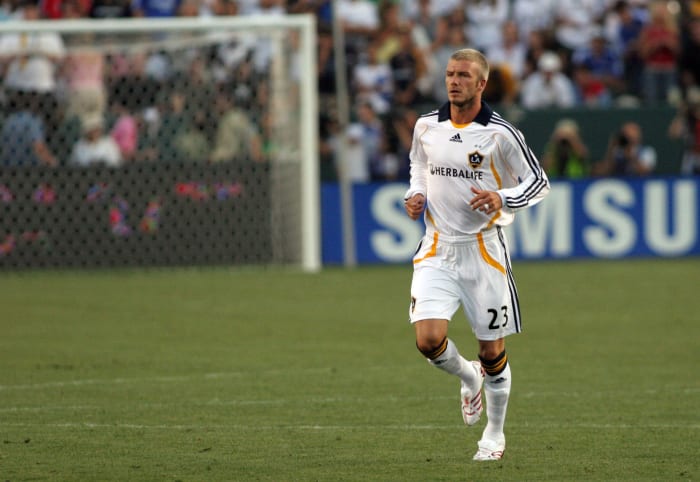
Back in the 2000s, soccer hadn’t really taken off in America. MLS was a league for players from the United States, maybe some from Mexico, and quite a few from Central America. Famous names in soccer played in Europe, unless they were South American and returning to their home country to end their career. Beckham was one of the few soccer players a lot of Americans could name. He was a celebrity, in part because of his marriage to Posh Spice. Beckham was also a really good player with Manchester United and Real Madrid, two clubs in the running for the biggest in the world. Then, in 2007, he signed with the Los Angeles Galaxy. MLS literally changed its salary rules to let the Galaxy sign a superstar in Beckham. Legitimately, Beckham signing with the Galaxy changed the soccer landscape and the MLS. It also looked super weird to see a guy who was a star for Manchester United playing in a Galaxy kit.
Allen Iverson - Detroit Pistons & Memphis Grizzlies
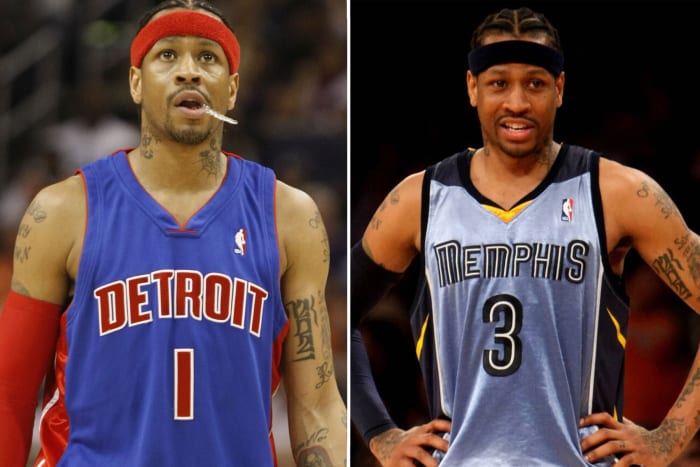
Iverson became a franchise icon in Philadelphia with four scoring titles, one MVP and one trip to the NBA Finals on his resume. He was eventually dealt to the Denver Nuggets and was paired with Carmelo Anthony, but could not re-create the magic he had in Philly. He had a brief stint as a Detroit Piston, then another with the Memphis Grizzlies before finishing his career as a 76er.
Ichiro Suzuki - Miami Marlins

The almost-unanimous Hall of Famer did the Griffey and ended his career with a swan song in Seattle. Even his couple seasons with the Yankees aren’t that odd because, well, they are the Yankees, and Ichiro was a star. However, we’ll never quite come to terms with the three seasons in the 2010s he spent as a Miami Marlin. It’s not just the sight of Ichiro in those weird Marlins uniforms of the era. Ichiro was no longer a viable MLB player by that point, finishing below replacement level in WAR all three seasons. To be fair, let’s not forget that Ichiro joined MLB when he was 27. By the time he signed with the Marlins he was in his age-41 season.
Aaron Rodgers - New York Jets
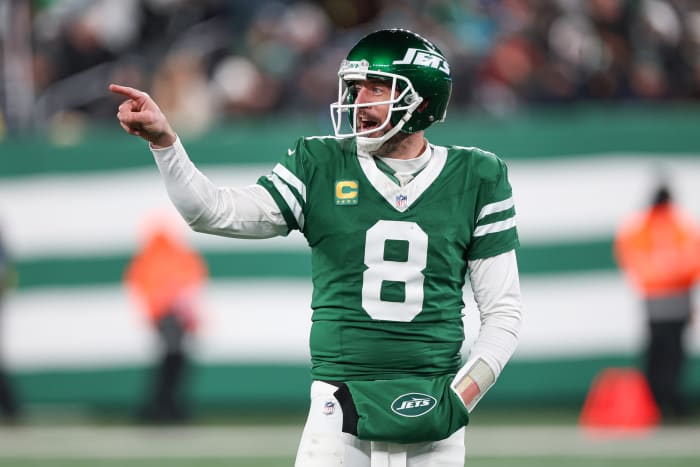
Rodgers followed in Favre’s footsteps pretty literally. Like Favre, he left the Packers after years of success and MVPs due to the presence of a quarterback-in-waiting. Also like Favre he moved to the New York Jets. The hype for Rodgers in New York died a quick, brutal death in 2023 as Rodgers tore his Achilles tendon only a few plays into the first game. While 2024 was rough for the Jets, Rodgers did low-key complete 63.0 percent of his passes with 28 touchdowns against 11 interceptions. That didn’t stop the Jets from going 5-12 and moving on from Rodgers, though.
Johnny Unitas - San Diego Chargers

Unitas was on the other end of Namath and the Jets’ huge Super Bowl upset win, but Unitas was the better quarterback of the two. He won three MVPs, and he did take home three titles as well, including in Super Bowl V. Unitas was actually only a spot starter and often on the bench his last couple seasons with the Colts, but he pushed on. The Hall of Famer was dealt to the San Diego Chargers prior to the 1973 season. Here, a changing of the guard happened. Unitas really struggled as the Chargers’ starter, and after he threw two picks in the first half of a game against the Steelers the Chargers coaching staff replaced him with a rookie quarterback. His name was Dan Fouts. One day, he too would be a Hall of Famer.
O.J. Simpson - San Francisco 49ers

The strangest thing about Simpson’s legacy is not his time with the 49ers. However, we’re here to talk about him in Niners gold, not prison orange. His many personal failings aside, Simpson was an incredible back with the Bills, including putting up the first 2,000-yard season in NFL history. O.J. spent two seasons with San Francisco, and while he managed to averaged 3.7 yards per carry across 23 games, he only scored four rushing touchdowns.
Hank Aaron - Milwaukee Brewers

“Hammerin’ Hank,” second all time in home runs, started his career in Milwaukee, but with the Milwaukee Braves. He then stayed with the franchise as it moved to Atlanta, where he broke Babe Ruth’s home run record. After the 1974 season, his 21st with the Braves franchise, Aaron wanted something new. He got it in something old. The Milwaukee Brewers now existed, and Aaron cajoled a trade to the city where he used to play. He had lost quite a bit of pop, as he slugged .360 over two seasons. Aaron did add 22 more home runs to his total, though, getting him to 755.
Ray Bourque - Colorado Avalanche
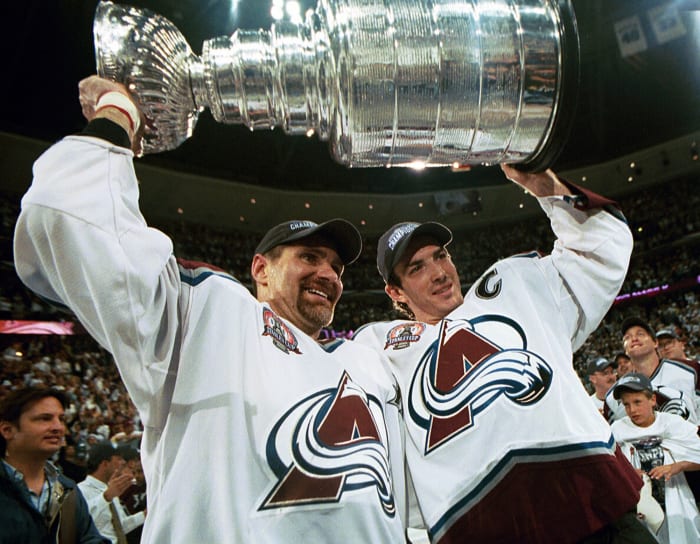
Bourque is in the running for the best defenseman of all-time, and he’s a Boston Bruins legend. He also played for them during a lengthy Stanley Cup drought. During the 1999-00 season, the Bruins and Bourque made the decision to let him move on to try and win a Cup before retirement. He ended up in Colorado, and while he played well, the Avalanche fell short. So, Bourque returned for the 2000-01 season. He had 59 points during the regular season and then was something of a personified rallying cry during the playoffs. Bourque had 10 points in 21 games as the Avalanche indeed won the Cup. The image of the defenseman finally hosting that trophy remains an indelible image.
Reggie White - Carolina Panthers
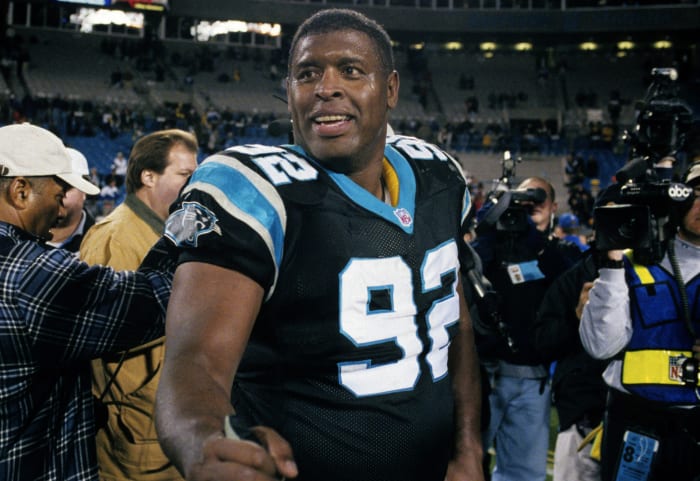
White won Defensive Player of the Year with the Eagles, and then again with the Packers. He actually retired in 1998 after winning his second award, but he was not done. White returned in 2000 with the Carolina Panthers. He played in all 16 games, but finished with only 5.5 sacks. White would retire again after one season with Carolina, and by 2004 he would be dead at the age of 43.
Lionel Messi - Inter Miami

Messi is still at it, and with the way he’s looked here in his late thirties maybe he will keep on playing for Inter Miami into his forties. On the other hand: The greatest soccer player of all-time is playing in the MLS. He’s playing for a Miami club that has only been around since 2018. By that point, Messi had already won five Ballon d’Or trophies. It’s truly remarkable that Messi is plying his trade with an MLB team. What if Tom Brady had played Arena Football? What if LeBron James played in the G League? What if Jaromir Jagr played into his fifties with a Czech hockey team? Wait, that last one has actually happened, and that’s a story for another day.
Shaquille O'Neal - Phoenix Suns, Cleveland Cavaliers & Boston Celtics

With Shaq, there are options. At the end of his career, for whatever reason, he couldn’t let go. That feels a bit odd for a guy who had so many interests outside of basketball. He was traded from the Heat to the Suns in the 2007-08 season and then played one full season there. Then there was his season with the Cavaliers. Finally, he finished his career with the Celtics, and that season was pretty rough. He only played in 37 games and averaged 9.2 points and 4.8 rebounds per game. Not a high note in his Hall of Fame career.
Karl Malone - Los Angeles Lakers

For years, John Stockton and Karl Malone joined forces as a dynamic duo for the Utah Jazz. The team won a lot of games, but the two didn’t win a ring together. Desperate for a ring, he (and Gary Payton) joined Shaq and Kobe on the Lakers for the 2003-04 season. For the first time since he was a rookie, “The Mail Man” didn’t average 20 points per game. It seemed like the move was going to pay off, as the Lakers made it to the NBA Finals and were the heavy favorites. Then, the no-stars, “Going to Work” Pistons upset them in five games. Malone retired without a ring.
Candace Parker - Las Vegas Aces

The second she dunked at Tennessee, Parker was arguably the face of women’s basketball. To the surprise of nobody, the Los Angeles Sparks made her the first-overall pick in 2008, and she immediately one the first of two MVPs with the Sparks. After 13 seasons with the Sparks, Parker made the move to the Chicago Sky, a personal move for the Naperville, Illinois native. She won a title her first year with the Sky, and she averaged over 13 points, eight rebounds, and four assists per game over two seasons there. Then, she made one more move, signing with the Las Vegas Aces as they built up a WNBA “superteam.” Parker only played in 18 games, and only averaged 9.0 points per contest, but she did get a third ring.
LaDainian Tomlinson - New York Jets

The San Diego Chargers will never regret trading the first-overall pick in 2001. Michael Vick was fine in the NFL, but the Chargers took Tomlinson fifth and got themselves one of the best running backs in history. Stop us if you’re heard this before, but Tomlinson would leave the Chargers in pursuit of a title. He landed with the New York Jets. The TCU alum was still a solid lead back in 2010, rushing for 914 yards and adding 368 receiving yards. Tomlinson returned for another shot at a ring in 2011 after the Jets fell in the AFC title game in 2010, but this year didn’t pan out. Tomlinson was a third-down receiving threat out of the backfield in a limited role and the Jets missed the playoffs.
Eric Lindros - Dallas Stars

Time has been kind to the legacy of Eric Lindros. Now that we understand how serious concussions are, Lindros' career is viewed through a different prism, and he got himself elected into the Hall of Fame. He was a star for the Flyers, but post-lockout he ended his career with a couple of one-off stops. First he played with the Maple Leafs and had 11 goals and 11 assists in 33 games in a season plagued with a recurring wrist issue. Then, in his final campaign, Lindros played with the Dallas Stars. He had 21 assists in 49 games, but only managed five goals.
Reggie Jackson - Baltimore Orioles

Here's something a little different. Jackson began his career with the Athletics, winning his sole MVP there. He was with that franchise from 1967 through 1975. From 1977 until 1981 he was a Yankee, where he became "Mr. October." Then he was an Angel, where he was an All-Star his first three seasons. Now, you may have noticed we skipped over 1976. What happened there? For one season, Jackson was an Oriole. There was this new thing in MLB called "free agency." Worried about said concept, the Athletics dealt Jackson to the Orioles. He considered sitting out the season, but instead played, slugged .502, and had 27 homers with 28 stolen bases. No wonder the Yankees then signed him to a big (for the time) free-agent deal.
Tony Parker - Charlotte Hornets

Tim Duncan, Manu Ginobili, and Tony Parker. That trio is synonymous with the Spurs, and those three are synonymous with one another. The first two were career Spurs. Parker, though, could resist pressing on. The French point guard was kind of lackluster in his final couple campaigns in San Antonio, and that continued with the Charlotte Hornets in 2018-19. Coming off the bench exclusively, Parker averaged 17.9 minutes per game. He managed 9.5 points and 3.7 assists per contest. Those numbers were actually an improvement upon his last season with the Spurs.
Pete Rose - Montreal Expos
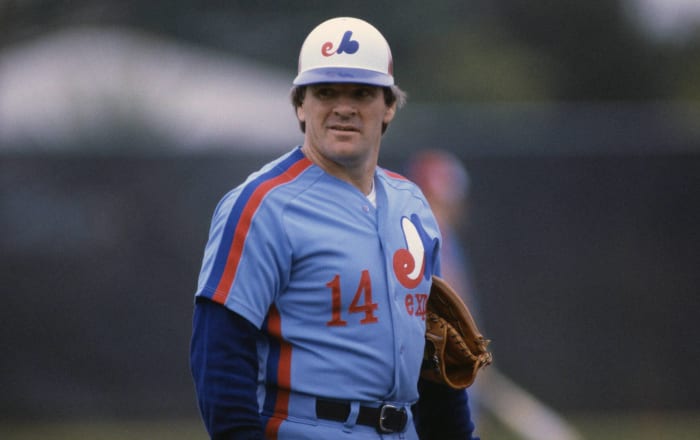
Rose began, and ended, his career as a Cincinnati Red. He became manager of the Reds after he retired, and then nothing notable ever happened. Even "Charlie Hustle" as a Phillie resonates with a lot of people. A sight that is truly odd to behold, though, is Rose as an Expo. He was already 43, but the Expos decided to sign him. It didn't go great. Somehow Rose only managed to slug .295 over 95 games. Montreal dealt him to Cincinnati and, again, everything was cool and chill from there on out.
Dwyane Wade - Chicago Bulls & Cleveland Cavaliers

Sure, with Miami, played with Shaq, and then he played with LeBron. When the team won rings, he was never the best player. However, because he was the guy who was a Heat pick and a Heat player through and through, he has the best legacy with the franchise. After 13 seasons in Miami, Wade signed a deal with the Bulls, but the Bulls were his hometown team so that wasn’t too odd. That team swiftly imploded, though, with Jimmy Butler traded and Rajon Rondo waived. Wade got himself a buyout and signed with the Cleveland Cavaliers. This pairing proved rocky, and the Cavs decided to reboot. After Wade played 46 games with the Cavaliers he was traded back to where he belonged, Miami. He ended his career with the Heat.
Yogi Berra - New York Mets

Because of his persona, and because the Yankees fielded so many stars during his time, Berra is overlooked some. Did you know he won three AL MVPs of his own? The guy was not just some quippy hanger-on in pinstripes. Yogi retired after the 1963 season and was immediately hired as the Yankees’ manager. Even though the team went to the World Series in 1964, Berra was fired after one year. He was hired by the New York Mets to coach first base, but that’s not all he ended up doing. In order to help out the team, Berra stepped in to player catcher a few times. Now, he only picked up nine at-bats, and only managed two singles, but he got out there a couple more times before being done as a player for good.
Sammy Sosa - Baltimore Orioles

Oddly, Sosa began his career with 25 games as a Ranger and then ended his career with 114 games as a Ranger. The slugger is best known for his time with the Cubs, of course. Well, what Sosa is "best known" for is a very different matter, but in terms of uniforms, it's the Cubbies. His worst season as a Major Leaguer, though, came with the Baltimore Orioles. Sosa began to peter out with the Cubs by the time he moved to the Orioles in 2005. He posted a sub-.300 OBP and, most notably for a guy who hit over 60 home runs in a season, slugged .376.
Philip Rivers - Indianapolis Colts
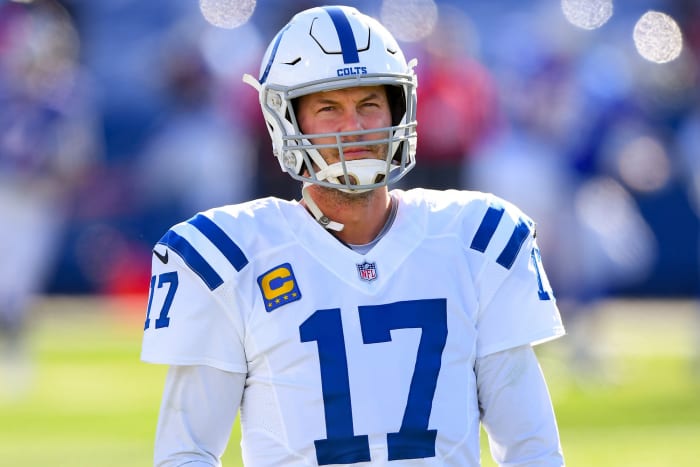
Rivers and Tomlinson were teammates with the Chargers, and while the two had some great seasons together, they never won that Super Bowl. Or even played in that Super Bowl, such as it is. Rivers kept playing and playing, so much so that he was a Los Angeles Charger as well. In his final campaign, though Rivers signed a one-year deal with the Indianapolis Colts. Once again he threw for over 4,000 yards and had 24 touchdowns against 11 interceptions. The Colts went 11-5 and made the playoffs, but lost to the Bills in the opening round.
Matt Ryan - Indianapolis Colts
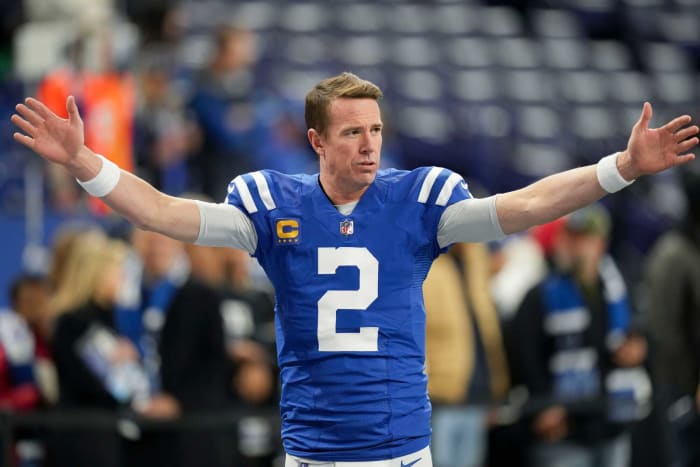
Ryan may have fallen a Super Bowl short of the Hall of Fame (that's to be determined), but he's the best quarterback in Atlanta Falcons history. He helped lift the franchise out of the Michael Vick mire caused by the dogfighting scandal. When the time came for the Falcons to move on, Ryan was still under contract and still wanted to play. He was dealt to the Colts where he struggled. Ryan made 12 starts in 2022 and had 14 touchdowns against 13 interceptions. Remarkably, he also fumbled a whopping 15 times. Ryan got released, he retired, and now he's a TV personality.
Bobby Orr - Chicago Black Hawks

Orr is hockey’s answer to Willie Mays. He was so exciting, so game-changing, and then he ended his career as a shell of himself for a team other than the one he became a legend for. Orr won eight Norris trophies, two Art Ross trophies, and three Hart trophies with the Bruins. Then, he signed with the Black Hawks (as it was stylized back in the day). Unfortunately, Orr’s knees caught up with him. He played in 20 games in the 1976-77 season, missed all of the 1977-78 season, and then played in nine games in the 1978-79 season before retiring.
Wade Boggs - Tampa Bay Devil Rays

Underrated in his heyday, Boggs won five batting titles with the Red Sox, and then he played for the Yankees. At the end of his career, the Hall of Famer added another legendary franchise to his resume: The Tampa Bay Devil Rays. Boggs signed with the Devil Rays prior to their inaugural season in 1998. He hit the first home run in franchise history and the team eventually retired his #12. All things considered, Boggs was solid for a forty-something professional athlete over his two seasons with Tampa.
Chris Chelios - Atlanta Thrashers
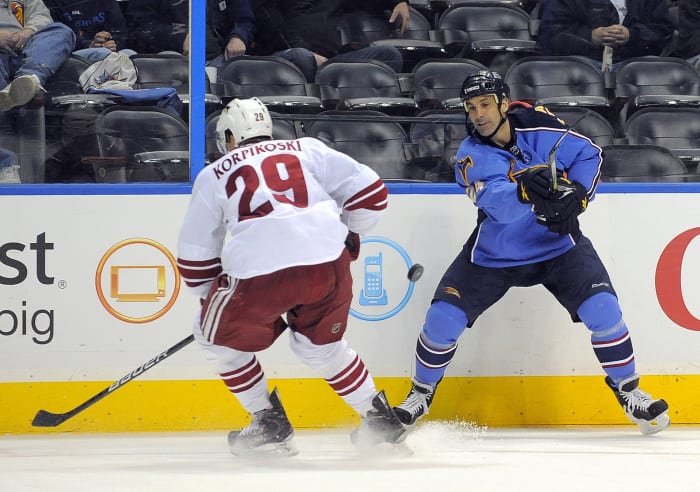
Chelios must have loved playing hockey. He had three Cups and three Norris trophies but just kept on playing well into his forties. In fact, at the age of 46, the Red Wings said they weren’t going to re-sign Chelios and he took a tryout contract with the Chicago Wolves. Yes, the AHL’s Chicago Wolves. He was the oldest player in AHL history and then earned a call-up from the Atlanta Thrashers. Chelios only played seven games with the Thrashers before being sent back down to the AHL. He retired at the age of 48.
Vladimir Guerrero - Baltimore Orioles

Vladdie is the forever face of the Montreal Expos, at least to the "'90s kids" out there, though he won his MVP as an Angel. Interestingly, though he retired after his age-36 season, Guerrero still squeezed in a couple one-off journeyman seasons at the end. With the Rangers in 2010 he was still a legit hitter, posting an .841 OPS with 29 home runs and 115 RBI. He was, reasonably, an all-star. Then, there was his campaign with the Orioles. Owing to his legendary bat skills, Vladdie still hit .290. However, he barely walked and his power was largely gone.
Ed Reed - Houston Texans & New York Jets

Reed is a Ravens legend. He led the NFL in interceptions three times in Baltimore and won Defense Player of the Year there. In 2012 he won a Super Bowl ring with the Ravens, and he could have gone out on a high note. Of course, had that happened, he wouldn’t be on this list. Reed returned in 2013 with the Houston Texans. His tenure lasted seven games before he was waived. The Jets signed him, and he did at least pick up three interceptions in seven games there. Reed then retired. After signing a one-day contract with the Ravens, of course.
Dominique Wilkins - Boston Celtics, San Antonio Spurs & Orlando Magic

Wilkins averaged over 30 points per game twice as a Hawk, back when he was a human highlight reel. Then, he became a journeyman, and it was a wild journey. Wilkins got dealt to the Clippers during the 1993-94 season, and he averaged 29.1 points per game over 25 outings. Then, he spent a season with the Celtics. His next stop? Panathinaikos in Greece, of course! This led to a lawsuit, but that’s a story for another day. Wilkins then spent a season with the Spurs, went back to Europe to play in Italy, and returned to averaged 9.3 minutes per game for 27 games with the Magic. The Magic, for what it’s worth, was rostering his younger brother Gerald at the time.
Peter Forsberg - Philadelphia Flyers & Nashville Predators

Forsberg was one of those future Hall of Famers who returned to NHL action after the season-long lockout facing a different landscape. Things went better for Forsberg than Hull, though. The Swede signed with the Flyers and had 75 points in 60 games. The “60 games” part was a harbinger, though. The next season he started with the Flyers but ended up with the Nashville Predators for 17 games. Forsberg wanted to keep playing, and even popped up a few times for the Avalanche, but over the course of four years he played in 11 NHL games before retiring.
Shaun Alexander - Washington
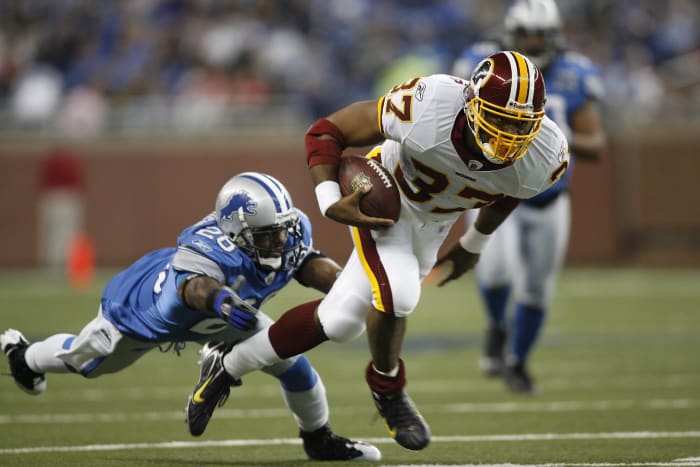
For a one-time NFL MVP, it feels like Alexander isn’t as well-remembered as you might think. Maybe it’s because that one season, 2005, was a real outlier for the back. Oh, he was quite good, but he only made three Pro Bowls. Those were all with the Seahawks. Once he clearly was losing steam Seattle was ready to move on, but Washington gave him a shot in 2008. It was pretty disastrous. Alexander lasted all of four games and got a mere 11 carries before being cut.
Frank Lampard - New York City FC

Lampard is one of the best box-to-box midfielders in English history and a legend at Chelsea. The kind of legend that gets a chance to manage the club even if he isn’t necessarily qualified to do so. However, he ended his career in the MLB, playing parts of two seasons with New York City FC. That’s the club owned by the group that owns Manchester City, which is a chance to remind you, in case you forgot, Lampard’s last Premier League season was not with Chelsea, but with City.
Sheryl Swoopes - Tulsa Shock
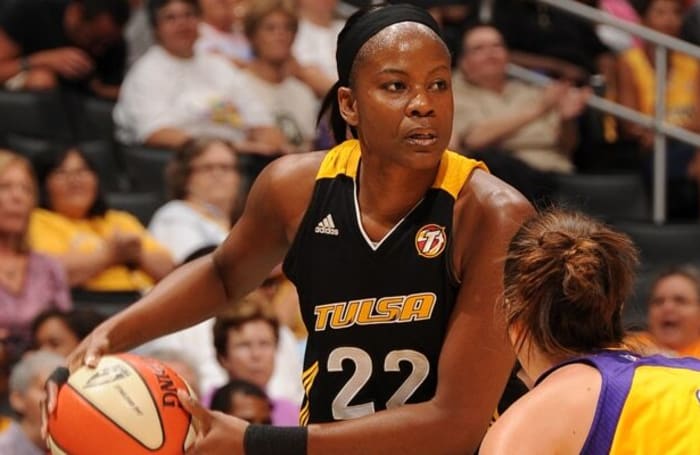
The Houston Comets were the juggernaut of the early WNBA. They won the first four titles, and Swoopes was on all four teams. She won her first of three MVPs with the Comets in 2000, the last of those title campaigns. After a decade in Houston, Swoopes moved to the Seattle Storm. The WNBA legend found herself in a secondary role, though, and only managed 7.1 points per game. The Storm waived her after one season, and it seemed Swoopes was done. Not so fast! In 2011, at the age of 40, Swoopes returned to the WNBA, this time with the Tulsa Shock. The Shock were a pretty poor team, so they could afford to let Swoopes take the spotlight. Though 40, she did not look out of place on a WNBA court. She played 30 minutes a night and averaged 8.2 points per contest. That’s not good, but for a 40-year-old who averaged 7.1 points the last time she played in the WNBA, that’s impressive.
Trevor Hoffman - Milwaukee Brewers

Hoffman wanted that 600th save so badly. Maybe he thought he needed it to make it in the Hall of Fame. Well, he’s in the Hall, so maybe it worked. After 16 seasons with the Padres, Hoffman moved to the Brewers. His first season, 2009, was good. Hoffman had 37 saves with an 1.83 ERA and made it into the All-Star Game. Then, the wheels fell off, but Hoffman pressed on. Nine saves shy of 600, Hoffman was brutal in 2010. He finished with a 5.89 ERA over 47.1 innings. However, he got 10 saves. Sure, they were paired with seven losses, but three cheers for round numbers!
Martin Brodeur - St. Louis Blues

He won four Vezinas, three Cups, and has played in more games and picked up more wins and shutouts than any NHL goalie. Also, more losses, but wins and losses are a silly goaltending stat anyway. Brodeur is an all-time great, even if he is mostly remembered for tending goal for the Devils teams that sucked the fun out of the NHL with their neutral-zone trap. Brodeur spent 20 years with New Jersey, and he’s as synonymous with that jersey as anybody. However, he ended his career with the St. Louis Blues. Brodeur was out of the NHL until the Blues suffered an injury to starting goalie Brian Elliott. He made five starts, then Elliott returned and the Blues made Brodeur the third-string goalie. This led to the Hall of Famer deciding to hang it up.
Mark Messier - Vancouver Canucks

Messier was too good to truly be in Gretzky’s shadow, but he did have to settle for being the Pippen to Gretzky’s Jordan for four Stanley Cups. Ahh, but he did lead the Oilers to one Cup after Gretzky left for the Kings, and of course Messier is a New York Rangers icon thanks to the 1994 Cup win. The Rangers beat the Canucks in that Cup finals. A few years later, Messier was playing in Vancouver. He spent three seasons there. Messier did fairly well, topping out at 22 goals and 60 points, but he didn’t deliver what the Canucks wanted, which was a Cup. He returned to the Rangers and ended his career where fans loved him.
Pedro Martinez - Philadelphia Phillies
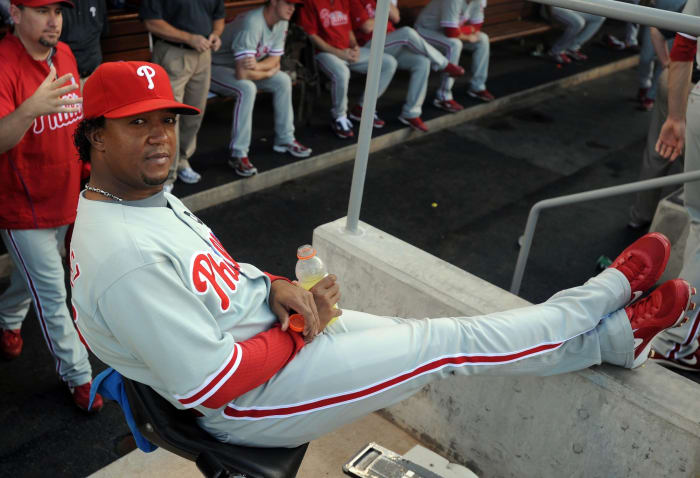
Obviously, most remember Pedro as a Red Sox ace. You likely even remember Martinez with the Expos if you’re old enough. His tenure with the Mets lasted a few seasons and a big personality was in a massive city, so that run is well-remembered too. Do you remember that Martinez spent his final season, the 2009 campaign, with the Philadelphia Phillies? He signed during the season and made nine starts. They went reasonably well, as Pedro posted a 3.63 ERA and the Phillies went 5-1 in his starts. The Phillies went to the World Series, and Martinez made two starts against his old nemeses the Yankees. Those starts didn’t go well, and Martinez’s last start in MLB saw the Yankees clinch another title.
Randy Moss - Tennessee Titans & San Francisco 49ers
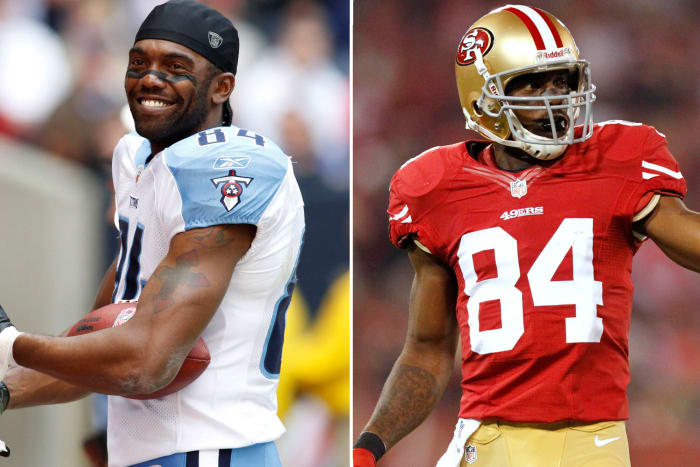
Moss took the NFL by storm with the Vikings, and even his brief tenure with the Raiders before his move to the Patriots is remembered well and doesn’t really feel odd. He was still in his prime and that tenure was so tumultuous it lodged in football memories. The end of Moss’ career, though, is easily forgotten. Do you remember the eight games in 2010 he played with the Tennessee Titans? Maybe not, as he only had six catches for 80 yards. Or what about 2012, when he returned to the NFL to play for the 49ers? At least that year he managed 28 catches for 434 yards and three touchdowns.
Julio Jones - Tennessee Titans, Tampa Bay Buccaneers & Philadelphia Eagles

Jones and Matt Ryan were a dynamic duo with the Falcons. The receiver made the NFL's all-decade team for the 2010s and twice led the league in receiving yards with Atlanta. In his final season as a Falcon, Jones dealt with injury issues and had a falling out with the franchise. This led to a trade to the Titans. Even though Jones was getting older and the Falcons had no leverage, they still got a second-rounder and a fourth-rounder for Jones an a sixth-rounder. Advantage, Falcons. Jones would never manage another full season in the NFL. He had 434 yards and a touchdown in 10 games with the Titans and that was his best year. Jones did less with the Bucs and then barely played for the Eagles in 2023.
J.J. Watt - Arizona Cardinals

Watt wasn't the first great player to suit up for the Texans for the bulk of his career, but he was the first all-time great to play for the franchise. Three-time Defensive Players of the Year can be counted on one hand. Looking to keep going after a decade in Houston, Watt signed with the Cardinals. His first season was rough and ended with an injury. In 2022, though, Watt showed his vintage form. He had 12.5 sacks, 18 tackles for loss, and seven passes defensed. With a TV career locked in, Watt retired on a high note.
Mike Piazza - Florida Marlins, San Diego Padres & Oakland Athletics

As a Met, Piazza was in seven All-Star Games. As a Dodger, he finished in the top-10 in MVP voting five times. He's in the running for the best catcher of his generation, and perhaps in history. Piazza spent the last two seasons of his career in San Diego and Oakland, and he was still pretty solid as a hitter. With the Padres he had an .843 OPS, and do recall this was back before the NL had the DH, so he wasn't getting days off from playing defense. The Marlins tenure, though, is truly funny. Having been in a protracted contract dispute with the Dodgers prior to the 1998 season, the team dealt Piazza to the Florida Marlins in May. That lasted all of a week. Piazza played five games for the Marlins before they dealt him to the Mets.
Randy Johnson - San Francisco Giants

Randy Johnson is arguably the greatest starting pitcher of the modern era, certainly the best modern-day lefty. Even with that accolade, he did bounce around quite a bit in his 22 seasons as a pro, playing for a total of six teams. But it's his brief forgettable stint in San Francisco with the Giants that landed The Big Unit on this list.
George Gervin - Chicago Bulls

Gervin began his tenure with the San Antonio Spurs when it was still an ABA team. He moved with the franchise to the NBA and took his game to a new level. On four occasions “Ice Man” led the NBA in scoring. He never failed to average at least 20 points per game with the Spurs. Then, of course, there’s his final NBA season. Gervin played with the Chicago Bulls in the 1985-86 season. He averaged 16.2 points per contest, which is not too shabby, if a step down. While Gervin was done in the NBA, he didn’t actually retire. Instead, he played in Italy, Spain, and for the CBA’s Quad City Thunder.
Wayne Rooney - D.C. United

One of the best scorers in Premier League history, Rooney was a stellar striker for Manchester United, and he bookended his time in the Premier League playing for Everton. He then did what had become trendy and played a couple seasons in MLS. Rooney played for D.C. United and tallied 23 goals. After that, Rooney did something old school. He signed with Championship side Derby County to be a player-coach. During his second season there, the manager was fired, and Rooney became a player-manager. Well, he was a player and part of a four-man management conglomerate. Once it was decided that Rooney would be the permanent sole manager, Rooney retired as a player.
Tim Brown - Tampa Bay Buccaneers

After winning the Heisman, Brown was a great receiver with the Raiders in the ‘90s and early 2000s. It just happened that the best receiver of all-time, Jerry Rice, was right across the Bay. Oh, and then was also on the Raiders. Brown played with the franchise in Los Angeles and Oakland from 1988 through 2003. The Hall of Famer then moved to another bay, Tampa. Brown spent one season with the Buccaneers but only managed 24 catches for 200 yards.
Earl Campbell - New Orleans Saints
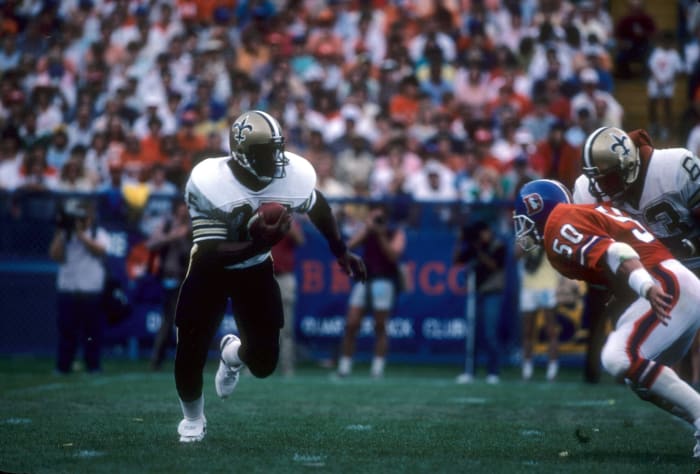
Campbell’s running style shortened his career, and unfortunately negatively impacted his long-term health. When he hit the NFL, though, he was otherworldly. In his first three seasons in the NFL, Campbell led the league in rushing yards and was Offensive Player of the Year. He also won Offensive Rookie of the Year and MVP in that time. All of that was with the Houston Oilers, and other than maybe Warren Moon, Campbell is the defining Oiler. During the 1984 season, though, Campbell was dealt to the New Orleans Saints. He only had 50 carries for the Saints that season, but he returned in 1985. This time around, Campbell ran for 643 yards but only had one touchdown. He considered returning to try and get to 10,000 rushing yards, but he realized his body had taken too much of a beating and retired.
Joe Thornton - Toronto Maple Leafs & Florida Panthers
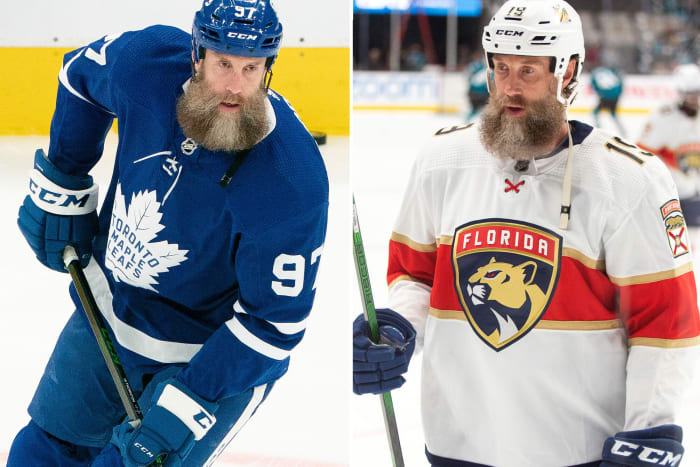
Cup-chasing can make some strange bedfellows in the NHL. Thornton was drafted first-overall by the Bruins and had a very good tenure there. Then, famously, he won the Hart the same season the Bruins traded him to the Sharks. Thornton had an illustrious run with the Sharks, but “Jumbo Joe” just couldn’t lead the team to a Cup. Thus, he signed with the Toronto Maple Leafs to provide veteran depth during the 2020-21 season, but betting on the Leafs to win your ring has proven a bad idea for decades. Then, the next year he signed with the Panthers and played fourth-line center for the most part. He only had 10 points, and he was there before the team did indeed hoist the Cup.
Patrick Marleau - Toronto Maple Leafs
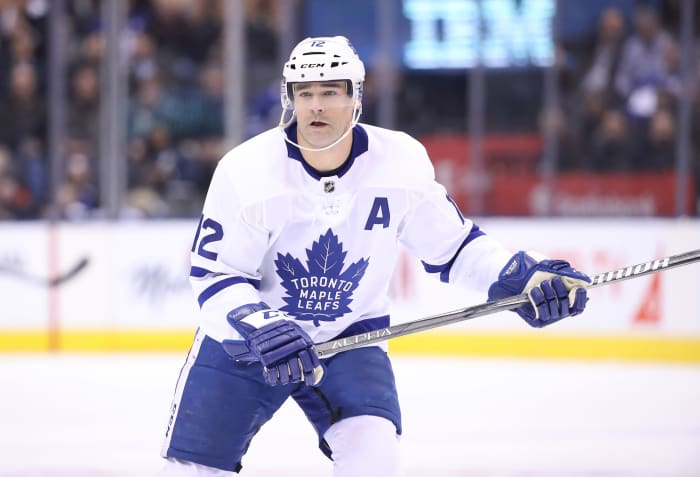
It’s fitting to pair Marleau with Thornton. The two are the greatest players in Sharks history, and they played together for ages. Also, Marleau was the guy San Jose took second overall after Boston took Thornton first. He could never stay away from the Sharks for long. Marleau spent two seasons with the Maple Leafs (not concurrent with Thornton) and did have a year where he scored 27 goals. He then re-signed with San Jose, but got dealt during the 2019-20 season to play with the Penguins. There was no Cup to be won, and Marleau spent his final season where he belonged, in San Jose.
Yolanda Griffith - Indiana Fever

An elite defensive player, Griffith won both Defensive Player of the Year and MVP in 1999, her rookie season with the Sacramento Monarchs. She made eight All-Star Games with Sacramento and led the league in both rebounds and steals twice. As the Monarchs started to languish (they would fold in 2009), Griffith moved to the Seattle Storm. She averaged 7.2 points and 6.3 rebounds in 2008, starting 30 games for Seattle. Griffith them signed with the Indiana Fever for the 2009 campaign, but tore her Achilles after three games and retired.
Bo Jackson - California Angels

On the football field, Bo was a Raider. On the baseball diamond, he is best remembered as a Kansas CIty Royal. After his football career ended due to his infamous injury, Jackson played two non-consecutive seasons with the White Sox. His final campaign, though, came with the California Angels. Because of his otherworldly athleticism, Jackson slugged .507 in the strike-shortened 1994 season. At peace with his time as a professional athlete, Jackson then retired at the age of 32.
Rasheed Wallace - Atlanta Hawks

One game. That's how long Rasheed Wallace's tenure lasted in Atlanta after being traded away from the Portland Trail Blazers. That game took place less than a week before the 2004 NBA All-Star Game. He was then shipped to the Detroit Pistons, where he would go on to play the best basketball of his career, and would help Detroit upset the Shaq-Kobe Los Angeles Lakers in the 2004 NBA Finals.
Dennis Rodman - Dallas Mavericks

Rodman's best seasons came with the Pistons, where he was a two-time Defensive Player of the Year. He wasn't "The Worm" yet, though. The tattoos and dyed hair and flouting of social conventions (plus the less fun stuff like kicking cameramen) did really start to happen until he was a Spur, and then it really took off when he was a Bull. People remember Rodman's brief tenure as a Laker, because they were the Lakers and he was Dennis Rodman. He then ended his career with a 12-game cameo as a Maverick. Because he's perhaps the best pure rebounder to ever live, Rodman averaged 14.3 rebounds per game, but that's all he was doing during that brief stint.
Eric Dickerson - Los Angeles Raiders & Atlanta Falcons

Due to Saquon Barkley prioritizing health over personal glory (and he has a ring so it was worth it), Dickerson remains the back with the most rushing yards in a single season. He did that with the Los Angeles Rams. Dickerson then pulled the reverse Marshall Faulk and went to the Colts where he led the league in rushing yards once. The Colts then traded Dickerson back to Los Angeles, but to the Raiders. He had a couple 100-yard games early on but started to show that time had caught up with him. Dickerson then was moved to the Falcons, but he only rushed for 91 yards over four games. When he failed a physical with the Packers, Dickerson knew it was time to retire.
Curt Schilling - Baltimore Orioles & Houston Astros
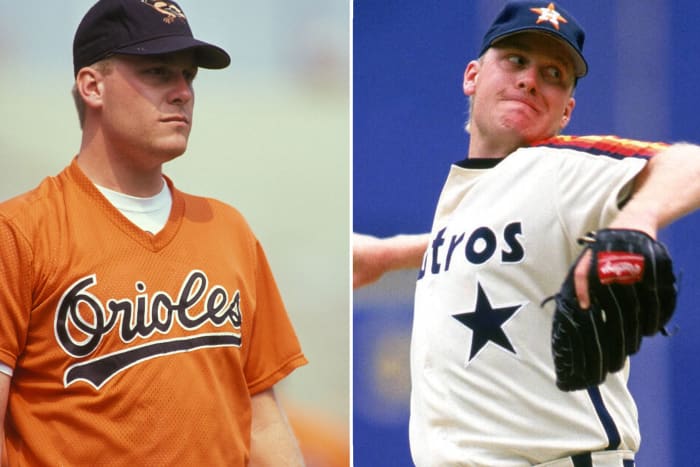
Sometimes, it's the beginning of an athlete's career that fades into distance. You don't remember the time before they made themselves memorable. When you think of Curt Schilling (on the diamond!) you think of the Phillies, the Diamondbacks, and the Red Sox. You think of upset World Series wins and bloody socks. You don't remember that he posted a 4.54 ERA over a smattering of appearances across three seasons with the Orioles. You don't remember him pitching out of the bullpen for the Astros in 1991. In 1992 he was with Philly, he had a 2.35 ERA, and he led the majors in WHIP. That was the "beginning" of Curt Schilling.
Keith Hernandez - Cleveland Indians

Through the power of "Seinfeld," Hernandez is an indelible Met (even though his best years came as a Cardinal). In the early days of "Seinfeld," though, Hernandez was briefly with Cleveland. Over 43 games he hit exactly at the Mendoza Line (.200) and was no longer the Gold Glove defender he had been for most of his career. Also, he was a little wooden on "Seinfeld" if we're being honest.
Raul - Schalke

There was a time when Raul was the all-time leading goal scorer for both Real Madrid and the Spanish national team. He spent 16 seasons with Real after coming up through the club’s academy. Then, wildly, Raul made the move to Schalke in the Bundesliga. He potted 28 goals in 66 Bundesliga games, but the German league is known for being high-flying and high-scoring. After that, Raul did what many soccer legends do and had a playing retirement. That is to say, he took a big payday to play a couple of years in Qatar.
Thurman Thomas - Miami Dolphins
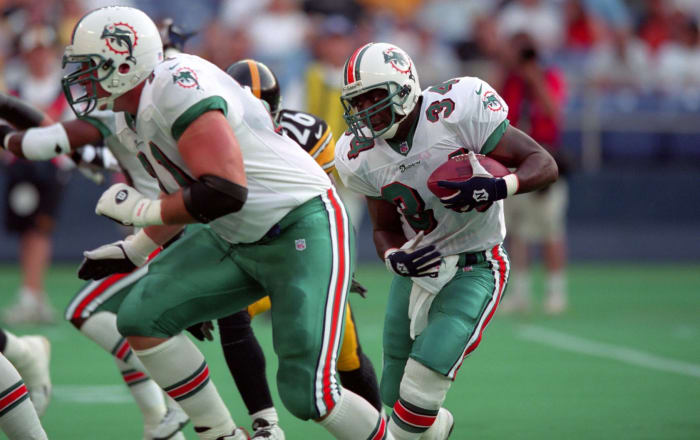
Before he retired, Thomas did a very retiree thing: He moved from Buffalo to Miami. As a part of those iconic '90s Bills teams, Thomas ran his was to one MVP and a spot in the Hall of Fame. The '90s had to end, though, and so for the 2000 season Thomas signed with the Dolphins. He averaged 4.9 yards per carry...but he only got 28 carries over nine games. Once he suffered a season-ending knee injury, he knew it was time to call it a career as well.
Alfredo Di Stefano - Espanyol

Di Stefano is an old-school name, but if you have any interest in soccer history, you’ve likely seen the Argentinean’s name. Considered to be one of the best players ever, Di Stefano won the Ballon d’Or twice with Real Madrid, and he is an icon of that club, a club that is not wanting for icons. In fact, after Di Stefano was banned from playing for Argentina by FIFA, he played 31 games (and scored 23 goals) in his adopted home country of Spain. He managed Madrid on two separate occasions. He died in Madrid. He ended his playing career with…Espanyol. Di Stefano played two seasons with the Barcelona-based side, the only two seasons of his career wherein he failed to score double-digit La Liga goals.
Chris Morgan is a Detroit-based culture writer who has somehow managed to justify getting his BA in Film Studies. He has written about sports and entertainment across various internet platforms for years and is also the author of three books about '90s television.
More must-reads:
- Three potential landing spots for pitcher Dylan Cease
- Edwin Diaz's comments on his future may worry Mets fans
- The 'World Series MVPs' quiz
Breaking News
Trending News
Customize Your Newsletter
 +
+
Get the latest news and rumors, customized to your favorite sports and teams. Emailed daily. Always free!
PRIVACY POLICY EDITORIAL POLICY CONTACT US
ABOUT YARDBARKER TERMS OF SERVICE
Use of this website (including any and all parts and
components) constitutes your acceptance of these
Terms of Service and Privacy Policy.
This site is for entertainment purposes only.
There is no gambling offered on this site.
Gambling Problem? Call 1-800-Gambler.








